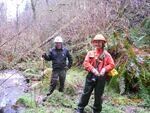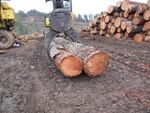
Garrett Groth, Reforestation Unit Forester on the Coos District, and Liz Dent, ODF Aquatic and Riparian Specialist, engaged in stream identification activities on the Elliott State Forest. Streams are classified as fish-bearing or non-fish bearing, and m
Oregon Department of Forestry
MEDFORD, Ore. -- Gov. John Kitzhaber and two other top state officials voted Tuesday for increased logging on the Elliott State Forest, on land that had previously been set aside for conservation.
Here are five things you should know about the forest and the decision to change how it's managed:
1. THE ELLIOTT FOREST IS UNIQUE
The Elliott is Oregon's first state forest, a 93,000 acre square in the Coastal Range just south of the Umpqua River. It was created in 1930 to consolidate state-owned land that had a mandate to provide income for public schools. Among the state's three forests, it's the only one with such a designated role.
Latest Development
Read about The Oregon Land Board decision on the Elliott State Forest and environmentalists' protests.
Although little true old growth remains in the Elliott, about half the forest is between 120 and 140 years old. It is home to 63 species of birds, including endangered spotted owls and marbled murrelets. The forest is also habitat for listed coastal coho salmon.
(Source: Ecotrust)
2. WHY THE STATE THINKS MORE LOGGING IS NECESSARY...
The Department of State Lands expects the new management plan will allow Oregon to more than double logging on the Elliott.
“We believe that 40 million board feet is sustainable yet healthy harvest level,” said Julie Curtis, a spokeswoman for the Department of State Lands. The State Land Board estimates the Elliott grows by about 70 million board feet a year.
The Land Board says that increase in logging will provide about $4 million a year in additional funding for Oregon's schools. Oregon is spending about $2.8 billion from its general fund on K-12 education this year.
Jim Paul, an administrator with the State Land Board, acknowledged that the state lands are a marginal source of school funding. But he said the board is still required by the Oregon constitution to generate as much revenue for schools as possible.
“It is a little ironic. When the trust funds were given to the state, the intention was that they would be the sole source of funding for public schools," he said.
Timber harvests and gross revenue for the Coos District, which is dominated by the Elliot State Forest
(Source: Ecotrust)
3. ...WHY ENVIRONMENTALISTS THINK IT'S NOT
Environmental groups protested Tuesday's decision in Salem. They contend the recommended level of logging is unsustainable and will harm endangered species.
Under the newly approved plan, the state will survey for endangered species before any timber sale, and protect a buffer zone, ranging from 25 acres to hundreds of acres, around any nesting sites they find. The strategy, called "Take-Avoidance," allows the state to comply with the Endangered Species Act without needing to receive an incidental take permit from the U.S. Fish and Wildlife Service.
The state is abandoning an agreement it reached with the U.S. Fish and Wildlife service in the 1990s to maintain a large tract of contiguous habitat for spotted owls in the northwestern portion of the forest. In exchange, the U.S. Fish and Wildlife Service had issued permits allowing timber sales in the southeastern area of the forest to take place in closer vicinity to spotted owl nests, potentially harming the owls.
State forestry and lands officials began re-negotiating with the U.S. Fish and Wildlife Service in 2001, when Oregon's permit for "taking" marbled murrelets expired. But state and federal officials failed to agree on a management plan.
View Elliott State Forest in a larger map
4. OREGON'S APPROACH ISN'T LIKE OTHER STATES'
"Oregon has a reputation of being a very environmentally-conscious state, but that's never really gotten in the way of harvesting Douglas fir trees," said Jerry Franklin, a professor in the college of forest resources at the University of Washington.
Franklin said he had not been following the Elliott State Forest management plan closely, but that take-avoidance is a conservation approach more typically taken by private timber companies than a public entity.
Franklin said Oregon's more traditional approach to timber management contrasts with states like California, Washington, Wisconsin, and Minnesota.
"Those states have done a really good job of incorporating ecological values into their timber management," Franklin said.
5. WHAT’S NEXT
The Oregon Board of Forestry will review the new plan next month, and is expected to approve it Nov. 3. Gov. Kitzhaber also directed the State Land Board staff to conduct an annual review of management in the Elliot.
"The debate is by no means over," said Paul, who is the assistant director of the Land Management Division. "There's a real conflict here that's hard to reconcile."






